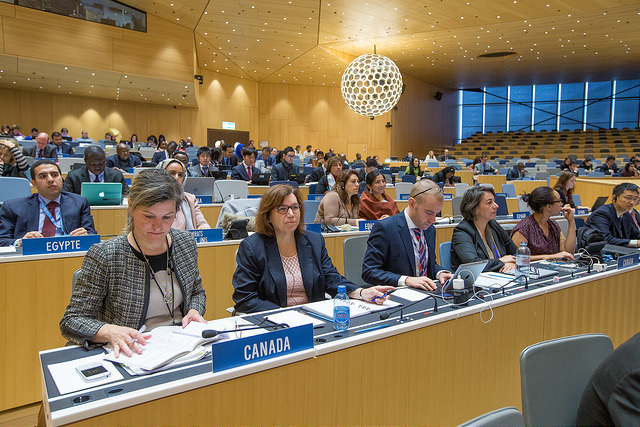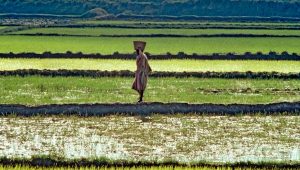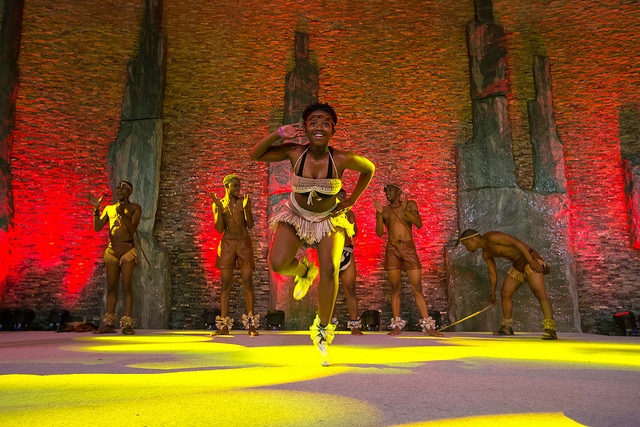WIPO’s Intergovernmental Committee on Intellectual Property and Genetic Resources, Traditional Knowledge and Folklore (IGC) 32nd session took place from November 28 to December 2, 2016. A Seminar on Intellectual Property and Traditional Knowledge was held on November 24 and 25, 2016, just prior to the IGC session.
On the agenda for this meeting, Item 6: Traditional knowledge was predominantly discussed. The committee reviewed “The Protection of Traditional Knowledge: Draft Articles” (WIPO/GRTKF/IC/31/4) last revised on March 28, 2014. The Chair introduced the discussion by reminding the committee that “in reviewing the objectives, Member States could reflect on which of the concepts detailed in the Policy Objectives set out in document WIPO/GRTKF/IC/31/4 were most directly related to IP, noting the mandate of the IGC was to “reach an agreement on an international legal instrument(s) relating to IP” for the balanced and effective protection of TK.”

Photo: WIPO – Emmanuel Berrod.
The Delegation of Canada, in response to a speech from the Delegation of Greece expressing the hope that “IGC would develop a common understanding on core issues and advance in a meaningful way”, conveyed their support and agreement, but questioned the concept of national authorities as beneficiaries. Currently, the draft article reviewed designates the Indigenous Peoples, local communities, and nations as beneficiaries of traditional knowledge, potentially offering national authorities power of control over ways in which traditional knowledge is used beyond the traditional and customary context. No formal agreement on the term used in the draft resulted from the meeting, with other delegations such Algeria suggesting to replace “nation” or “national authority” by national bodies or competent bodies. The Delegations of Ghana, Nigeria and Thailand indicated that on the contrary, they were in favor of a definition that would be as inclusive as possible to identify and recognize IPLCs (Indigenous Peoples and Local Communities) and States as beneficiaries.
In another response, the Delegation of Canada expressed their concern over the wording of the draft article, mixing the definition of Traditional Knowledge, the subject matter of the instrument and the scope of protection. They suggested that the IGC “had to come up with one clear, well-drafted statement about what was the subject matter of the instrument.” Their intervention sparked discussion over the definition of key words such as traditional and protection. Further in the meeting, Canada expressed again their request for clarification, asking for instance what the terms “dynamic and evolving” added to the definition in Article 1 of the draft: “The subject matter of [protection]/[this instrument] is traditional knowledge: (e) which may be dynamic and evolving.”
They suggested two options:
(1) a well-drafted definition of TK could be referred to in the article on “Subject Matter”, or
(2) a stand-alone article with the definition of TK that would be covered by the instrument
In response to this debate, the Chair reminded the committee that “the material presented was simply work-in-progress, and it had no status and was not a revision. It was just some ideas and thoughts that the facilitators thought were worthy of presenting and getting initial comments on before working on the first revision.”
The Chair later discussed the introduction of a tiered approach to the scope of protection, “whereby different kinds or levels of rights or measures would be available to rights holders depending on the nature and characteristics of the subject matter, the level of control by the beneficiaries and its degree of diffusion. The tiered approach proposed differentiated protection along a spectrum from TK that was available to the general public to TK that was secret/not known outside of the community and controlled by the beneficiaries. That approach suggested that exclusive economic rights could be appropriate for some forms of TK (for instance, secret TK, and TK uniquely attributable to the specific IPLC), whereas a moral rights-based model could, for example, be appropriate for TK which was disclosed, already publicly available but still attributable to a specific IPLC.”
Canada conveyed their interest in such approach, with some reservation in regards to the practical measures as applied and interpreted by administrative or judiciary bodies of the Member States. They suggested once again the need for clarification, concrete information and agreement from all parties before moving the discussion forward.
As reminded by the facilitators, the discussion and debates recorded during this meeting were not meant to be an official revision of the text. “It was meant to elicit further comments from Member States on the core issues prior to production of a Rev 1. […] The objective was to aid in the development of a cleaner, simpler, more streamlined text that captured and reflected common positions on core issues.”







